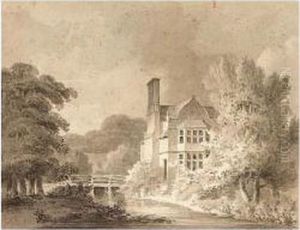George Stanley Repton Paintings
George Stanley Repton, born in 1786, was a prominent British architect and landscape designer, carrying forward the legacy of his father, Humphry Repton, who was one of the last great English landscape designers of the 18th century and considered the successor to Capability Brown. George Stanley Repton's career was deeply influenced by his father's reputation and work, which allowed him to collaborate on several prestigious projects across Britain. His works reflected a seamless blend of his father's landscape sensibilities with the architectural trends of his time, making significant contributions to early 19th-century British architecture and landscape design.
After his father's death in 1818, George, along with his brother John Adey Repton, continued the family business, working on both landscape projects and architectural designs. They completed several unfinished projects initiated by their father and undertook new commissions, expanding the Repton legacy into the Victorian era. George Stanley Repton's approach to design was not just limited to landscapes but also included the architectural restoration of old buildings and the design of new ones, integrating them into the landscape in a harmonious manner. This holistic approach to design was a testament to his understanding of his father's principles and his ability to adapt them to the changing tastes of the time.
Throughout his career, George Stanley Repton was known for his versatility, working on a wide range of projects from private gardens and parks to country houses and ecclesiastical buildings. Despite the overshadowing fame of his father, George managed to carve out his own niche in the architectural world of the 19th century, contributing to the evolution of landscape gardening and architecture. His works, though not as well-documented as those of his father, continue to be studied for their contribution to the development of English landscape architecture and their reflection of the transition from the picturesque style of the 18th century to the more formal and structured approaches of the 19th century.
George Stanley Repton's death in 1858 marked the end of an era for the Repton family's involvement in architecture and landscape design. However, the legacy of the Repton name, through the works of both Humphry and George Stanley, remains influential in the fields of landscape architecture and design, illustrating a bridging of generational talents and the evolution of English landscape and architectural styles across the 18th and 19th centuries.

